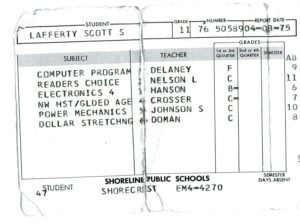In his senior year at Shorecrest High School Scott took a course in computer programming, and failed it.

Twelve years later when newspapers and magazines were raving about what an amazing programmer he was, he seemed to take some pleasure in pointing out this failure.
I don’t know why he failed that class, but I suspect it had to do with his ability to read fast enough to keep up with the class. As he pointed out in one interview, “I was one of those students who was pushed through the system. I have a real hard time reading.”
What nobody realized at the time was that Scott’s difficulty in reading was due to a condition known in the scientific community of the time as dyslexia, but not yet really recognized in the school system. To most of his teachers Scott was a fairly likable but also fairly stupid kid, who would never amount to much. So the kindest thing they could do was pass him along and get him out into the real world (or in his case the reel world) where he could make a living doing something that didn’t require a lot of intelligence.
Scott once told me what it was like for him to read a normal paragraph of text. When he looked at the first word the letters in it might appear to be in any order. He had to rearrange those letters until they became a real word in the English language. He then looked at the next word and did the same thing. Then he had to look at that combination of two words and decide whether they logically went together in a sentence. And then he had to repeat that process for each word, adding them one by one to the growing string of words that eventually became a sentence.
Although it was hard for Scott to read, once he did read something it was fixed firmly in his memory…he had total recall of almost everything he had ever read. If he needed to check something he didn’t open the book and look for that point, he just accessed that page in his memory.
Over the years it became a little easier for Scott to work his way through text, but he never really enjoyed it. Computer code, on the other hand, was easy. He could read it and write it and totally understand it.
In another revelation he told me how he mentally developed a program before he started typing each day. He typically spent about an hour every morning laying in bed with his eyes closed before getting up. He pictured the various code modules in a project as colored blobs, with input and output lines connecting them. He could “see” the code in each blob, and as he provided input and ran the code he could see the output go to the next blob for processing, and so on through all the blobs. As he looked at the output of each blob he could tell whether the code was doing what he wanted, and if not, could modify it and try again. When his input ran through all the blobs with no problems, he could get up and start typing.